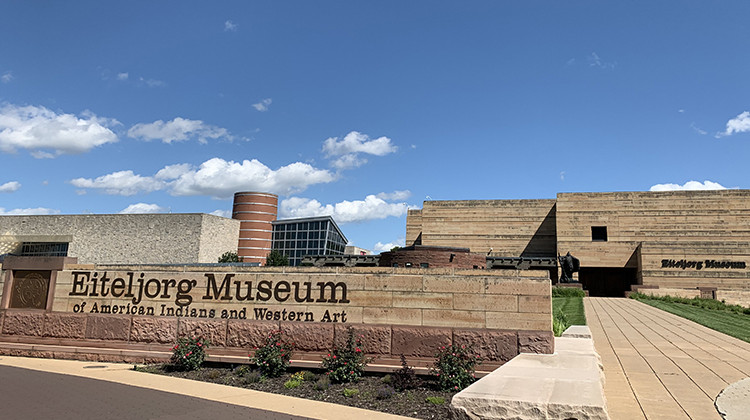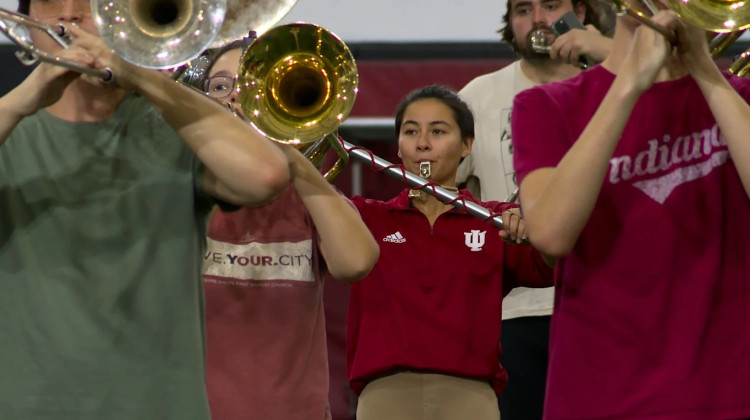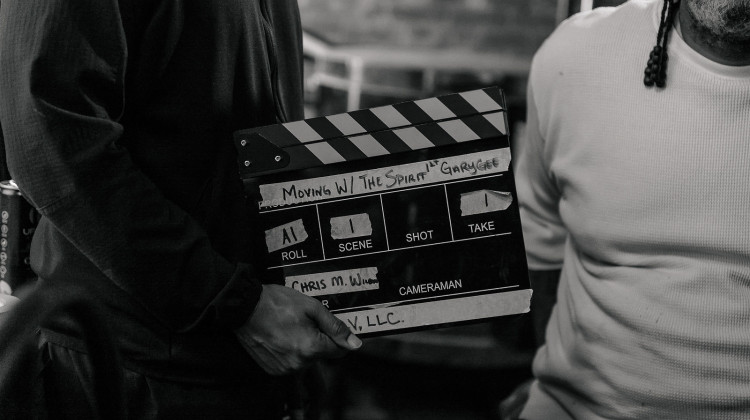DOMENICA BONGIOVANNI - The Indianapolis Star
INDIANAPOLIS (AP) — The Eiteljorg Museum ’s revamped Native American Galleries will show works spanning more than 170 years when they reopen in June. But visitors won’t start at the beginning, middle or even the end of that timeframe. Instead, they’ll be greeted by artwork with stories that fuse past, present and future.
Hannah Claus’ “water song: peemitanaahkwahki sakaahkweelo,” for example, wraps the Miami people’s origin story into a work she created as a 2019 Contemporary Art fellow at the Eiteljorg. She took photos around their homelands in the Mississinewa and Wabash river areas, between Marion, Peru and Wabash.
In doing so, Claus, who is a member of the Bay of Quinte Mohawks First Nation, explored the story of how the Miami first reached from the water in the area of present-day northern Indiana and southern Michigan to grab tree branches and pull themselves onto the land to walk. Digital imagery printed on acetate film in the form of discs will hang delicately from threads affixed to the ceiling, reflecting the story and the sound waves of a song written about it.
“water song” will be an introduction to about 300 artworks, with more cycling into the installation over time, that will tell the story of tribes from across North America through a thematic presentation that centers Native cultural values in the galleries.
“Native art is on this continuum that what’s considered older or traditional and what’s newer or contemporary — it’s all Native art and they inform one another,” said Dorene Red Cloud, associate curator of Native American art.
The piece also will stand amidst spoken greetings from Great Lakes tribes and written acknowledgement of the peoples — including the Miami, Potawatomi, Delaware, Shawnee, Peoria and Kickapoo — who are the original inhabitants of the land where the museum now stands.
The reconstructed Native American Galleries are part of the Eiteljorg’s larger Project 2021, a $55 million fundraising campaign that will add to its endowment and re-envision galleries and events space. Of special interest to those from this region is the spotlight on Native peoples of the Great Lakes, which is expanding after the museum acquired a major collection of their art in 2019.
“This is really transformational for the museum. We’ve gone for 30 years in a certain mode, and now we’re looking at the art differently and we’re presenting it to the public very differently,” President and CEO John Vanausdall said. “It’s going to look so dramatically different and I think much more contemporary and inviting for today.”
Before the renovation, Native American art sat in large wooden cases, placed according to its geography into categories that included the Woodlands, Plains, Great Basin and Desert Southwest. The floorplan was largely the same as it had been since 1989, when the Eiteljorg opened.
Working with its national Native American Advisory Council, the Eiteljorg developed a new vision for the galleries that is organized into the themes of Relation, Continuation and Innovation, which are important across Native cultures.
Artworks — which include jewelry, pottery, prints, portraits, ribbonwork and beadwork — will be displayed in glass cases that greatly open up the space.
“One of the biggest changes from the old exhibit to the reinstallation is looking at the art through these three major themes because previously, we took — as did many other museums — an anthropological look at the art and the people and the cultures and really categorizing people by geographic area. So you had people of the plains, people of the southwest,” said Elisa Phelps, who is the vice president and chief curatorial officer.
“That really is a non-Native perspective on looking at the art and the cultures and the peoples.”
The theme of Relation explores the connections to spirits, animals, plants, families, communities and nations. Red Cloud said that Native peoples’ creation, or origin, stories will be part of this section. Mesa Verde national park in Colorado and Cahokia Mounds, which is just east of St. Louis, are among places that are ancestral to today’s tribes but not properly recognized as such, she said.
“Native peoples have lived in North America for thousands of years. And when European settlers came to America, they saw these mounds and other places and didn’t give credit to the living Native peoples that were there,” Red Cloud said. “If you talk with Native peoples who are descended of these areas, they will tell you, ‘Oh those are our relatives, those were our ancestors.‘”
Continuation celebrates the Native practices and observances that thrive despite assimilation efforts, while it explores forced removal and relocation as well as the schools meant to rid children of their culture. Finally innovation includes Native artists’ entrepreneurship in creating and selling their work.
About 15% of the galleries’ artworks will be from the collection the Eiteljorg previously acquired from art dealer Richard Pohrt Jr. The items, which were created by Great Lakes Native peoples in the mid-19th and early 20th centuries, give a broader understanding of Indiana’s past and present.
The new art from Pohrt adds a great deal of diverse work to the museum’s existing Great Lakes collection, which had previously been small compared to others, according to public relations manager Bryan Corbin. The Eiteljorg had displayed some of that work from the Miami, Delaware and Potawatomi in “Mitohseenionki: The People’s Place” since 2002. Now, some of those items will be in the reconstructed galleries.
Other Miami and Potawatomi artworks that were shown previously in the galleries were on loan and have been returned after almost 20 years on exhibition.
This section of the reinstallation will focus on tribes’ connections to the Great Lakes as well as contemporary environmental issues, like pipelines in the area and returning varieties of seeds to their place of origin in Native communities.
Artworks by people from the Great Lakes and surrounding areas will be threaded throughout the reinstalled galleries and specifically spotlighted in the Connected By Water room. With a dark ceiling and walls, art like textiles and moccasins will be inside lit-up boxes.
“You’ll be in this jewel box-like setting,” Phelps said.
Given many works’ sensitivity to light, the art will rotate, which will help the museum show more of the 400-plus items from the Pohrt collection, Phelps said.
The tribes’ art and skill will be evident, and Red Cloud said the exhibit offers an opportunity to teach about their spiritual beliefs through images used in the works, like those of thunderbirds and underwater panthers. Again, past and present will unite through works like a turn-of-the-20th-century bandolier bag with floral beadwork, an art form that continues.
On “the bandolier bags, you’ll see a lot of floral patterns — floral and plant. They’re based on plant knowledge that people have, you know, what kind of plants are beneficial to use for medicine or to eat,” Red Cloud said. “The floral beadwork is something you only find in the Great Lakes area, and the artists are still doing it today.”
Construction of galleries is ongoing as the Eiteljorg moves into the final fundraising phase of Project 2021. In October, the museum announced its goal to raise more than $6 million by May after receiving almost $49 million during the private phase that began in 2016. Part of the money — $40 million — will be added to its endowment. The remaining $15 million will go toward its capital campaign.
Along with the Native American Galleries, the latter includes the reconstruction of the Western Art Galleries, which reopened in 2018; renovation of the Nina Mason Pulliam Education Center, which reopened in November; and the future expansion of the Allen Whitehill Clowes Sculpture Court events space. Corbin said that the museum has raised more than 90% of its overall goal so far.
Audio descriptions, digital tools, information that’s easily seen by those who use wheelchairs, and special lighting for people who are visually impaired will make the galleries more accessible. Visitors will be able to touch parts of the exhibitions, too.
The additions include videos from Native artists who explain their work. These voices are key to telling the stories of the art and people behind it, Phelps said. Even in the midst of enduring painful situations throughout Native peoples’ history, Red Cloud said the galleries will show the perseverance and joy of their cultures.
“People are still culturally alive and viable as reflected in art,” she said. “Art practices are still continuing and evolving, and that’s when we get to innovation and really celebrate Native art and its diversity.”
—
Source: The Indianapolis Star
 DONATE
DONATE







 Support WFYI. We can't do it without you.
Support WFYI. We can't do it without you.